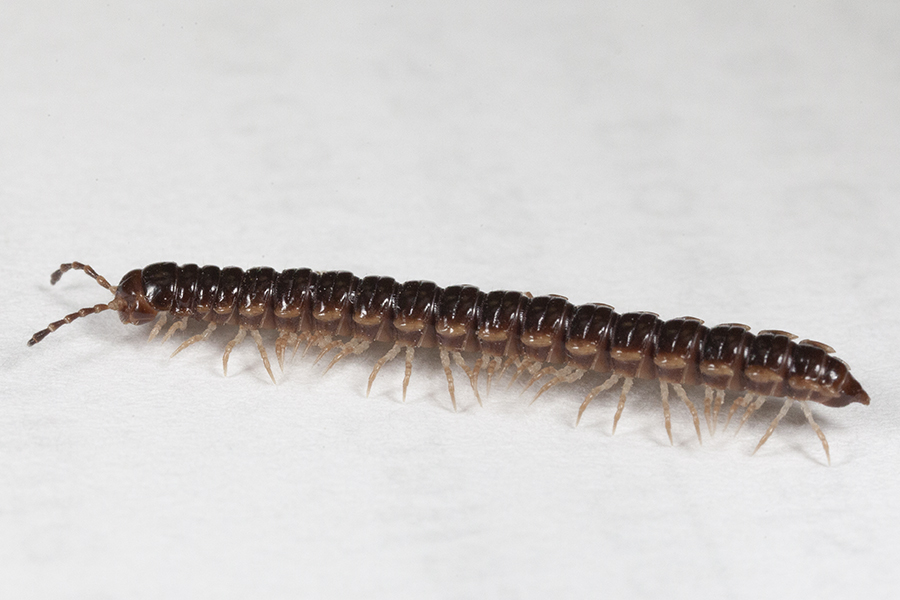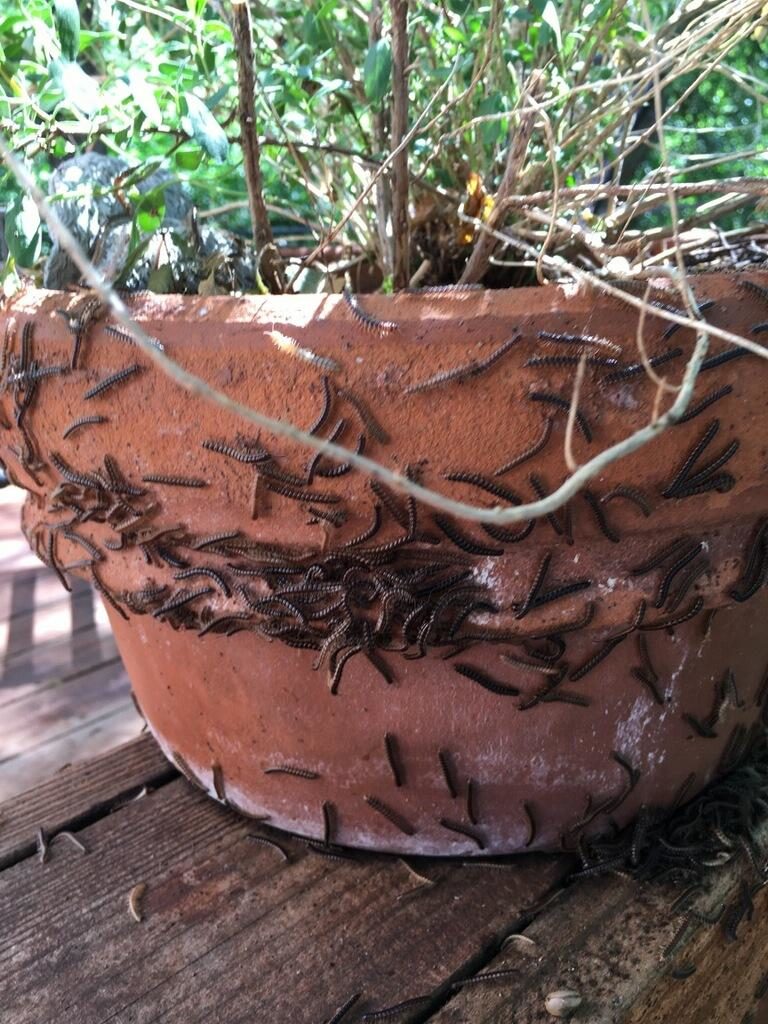
Given the right conditions, millipedes can reach impressive numbers around homes and in the garden. Oxidus gracilis, or the greenhouse millipede, is a common species in Texas. This one appears to have over 30 pairs of legs. Photo: M. Merchant.
At first glance, millipedes are most remarkable for their ability to walk without tripping over their own feet. The name millipede literally means “thousand feet” and though most don’t have that many legs, that’s still a lot of feet to keep track of. What’s even more remarkable about millipedes, once you get to know them, is their ability to reach astronomical numbers when weather conditions are prime.

Millipedes clinging to a clay pot, probably for moisture. Most millipedes are very sensitive to dry air.
That’s what’s happening right now, at least in parts of north and east Texas. For the past month Extension offices have been getting dozens of calls about (sometimes) biblical numbers of millipedes. One person today described finding millipedes throughout his home, “too many to count, entering through the house windows and doors,” like the hundred or so he found in his son’s second story windowsill.
Sometimes mistaken for caterpillars, such infestations begin outdoors with dozens or hundreds of millipedes swarming flower pots and crawling up the sides of buildings.
Millipedes aren’t all bad. Their role in nature is to serve as “decomposers,” feeders on dead plants and decaying wood. Without critters like millipedes you wouldn’t be able to get new grass to grow through the layers of dead grass and leaves, and compost piles would take longer to produce compost. But this doesn’t stop them from sometimes becoming a royal nuisance.
Several years ago a brand new, local high school was invaded by millipedes. They stormed hallways and classrooms by the tens of thousands. With no landscaping or mulch nearby, the only food source we could determine were buried heavy-duty cardboard boxes used by construction crews on the soil to support the floating slab foundation of the buildings. Structural engineers figured the cardboard would decay innocently under the slab, but entomologists will tell you that burying paper under a building is asking for trouble in the form of termites and millipedes.

Some millipedes emit noxious defensive secretions when threatened. This child was playing with a millipede, rolling it in her hands. She soon had these itchy red stains. Photo courtesy Kim Benton.
Millipede mass migrations commonly occur in the fall, but can also happen in the spring. Above average rainfall is likely to blame for this year’s invasions. But such invasions don’t occur overnight, as it takes millipedes several months to develop. It may be that waterlogged soils are forcing millipedes out of the soil in search of drier spots. Unfortunately for the millipedes that enter homes, indoor environments are too dry for their thin “skin”. Though millipedes are relatively long-lived outdoors in the soil (up to 5-7 years), once indoors, millipedes desiccate and die within a matter of hours.
For this reason it’s usually unnecessary to spray insecticides indoors for millipedes. Instead use the vacuum indoors and focus your control actions outdoors. Make sure mulch is kept away from building foundations, and that weep holes and other entry points are screened or sealed. In severe cases it may be helpful to apply a pyrethroid insecticide (in the form of granules or sprays) around the perimeter of the home and around windows and doorways. Most of the time, however, millipede infestations go as quickly as they came, and insecticides are not needed.
Millipede jaws are soft, restricting most species to feeding on soft, dead plant material. Only a few, like the greenhouse millipede, can damage soft plant tissues such as found on emerging garden plant. Millipedes do not bite, but some species can emit noxious defensive secretions that can stain and even blister skin.
You have to respect millipedes. With only weak jaws, thin skins, and little more to their credit than lots of legs and incredible powers of reproduction, they manage to survive and thrive even in our urban landscapes.